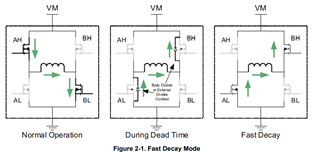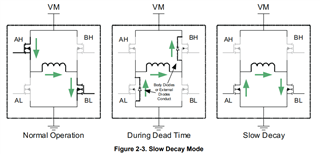I have a few questions about the DRV8841 and hoping you can help or point me in the right direction. I've implemented the DRV8841 in my design but with current regulation disabled, meaning the current sense inputs and current scaling control pins have been grounded. The chip features a decay pin that selects a decay mode, either fast or slow, to be used when changing direction or braking.
Even though I've disabled current regulation, does the chip still perform some form of decay mode? If left open, the datasheet indicates that it performs mixed decay.
I don't think this is the case but just wanted to clarify and if not, do you know what the control scheme is during braking? I'm not able to see the gate pins of the FETs so it's not clear what's happening internally.



